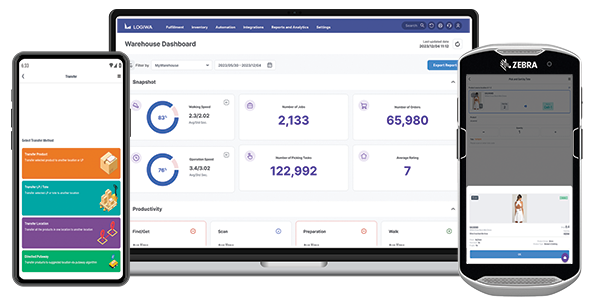Knowing how much inventory you have in stock can make or break your business. If you have too much, you’re wasting money. If you have too little, you’re losing sales because you can’t keep up with customer demand. Inventory control procedures are crucial today, especially since global ecommerce spend is expected to be over five trillion dollars in 2022.
As online shopping continues to increase across the world, DTC operators must keep up with the pace. Effective inventory control is a business imperative.
In this guide, we’ll explore:
- What Is Inventory Control?
- Critical Inventory Control Elements and Formulas
- How Does Inventory Control Work?
- Why Is Inventory Control Important?
- Pros And Cons Inventory Control
- FAQs
What Is Inventory Control?
According to Merriam-Webster, the correct definition of inventory control is the “coordination and supervision of the supply, storage, distribution, and recording of materials to maintain quantities adequate for current needs without excessive oversupply or loss.”
But what does that mean?
Another – and clearer – way to define inventory control is this: it’s an essential part of your business because it will give you control over your inventory/stock. This will help you to stay on top of orders and customer demand. Inventory control procedures and systems will ensure your inventory control is organized, timely, and accurate.
Accurate inventory management is the most important factor. An accurate inventory control system increases sales, ensuring you have the optimal amount of product on hand at all times. Implementing and utilizing warehouse inventory management software will help you gain control of your DTC process and increase volume.
With good inventory control procedures, you can automate your inventory management process and make the process of running a business much easier. Warehouse and inventory management software can help you optimize staff, waste less time, and take advantage of precious space.
Many business owners don’t understand just how vital inventory is for the success of their business, and that has led to many unfortunate failures. To avoid failure, ensure that you have a working inventory control system in place.
Critical Inventory Control Elements and Formulas
Many elements are important for your inventory tracking, such as:
- Days In Inventory Formula: this is a formula that calculates the average time a company keeps its inventory before it is sold (divide the average cost of your inventory by the cost of goods sold and then multiply that by the period length)
- Average Inventory Formula: this is a formula that calculates the way that your inventory items averaged over two periods (add the inventory counts at the end of each period, and then divide by the number of periods you’re looking at)
- Perpetual Inventory System: this is a program that constantly works to estimate your inventory based on your sales, returns, and other electronic records, rather than by looking over a physical inventory
There are, of course, other important elements, but these are three core formulas that will help guide your inventory control procedures.
A solid inventory control system will integrate all parts of the supply chain procedure into one singular system (purchasing, shipping, receiving, warehousing, etc.).
Keep in mind that inventory control differs from inventory management. While both handle aspects of monitoring your inventory, inventory control works with the inventory that a business already has in its warehouse. Inventory management, however, also deals with when you receive inventory, forecasting, and product reordering. They work hand in hand, but you can increase the quality of your inventory management when you improve your inventory control.
Warehouse inventory management software can optimize inventory control and take ecommerce operations to the next level. Many manual processes can be automated to increase productivity and visibility into processes. Logiwa’s WMS software does exactly that, removing cumbersome manual tracking from inventory control procedures.

Transform your warehouse to a DTC fulfillment center
How Does Inventory Control Work?
There are three main inventory systems, and they work in different ways. The three types of systems are manual inventory systems, perpetual inventory systems, and periodic inventory systems.
Manual Inventory Systems
As you may be able to guess, these systems require a human being physically takes account of what you have in your inventory. This is the least accurate method because it’s subject to human error and mistakes. Additionally, it may take more time and money because it has to be done by hand and requires more payment for labor to fulfill tracking.
Perpetual Inventory Systems
These are inventory systems that constantly update your records. They also account for subtractions and additions when you receive inventory items, when you sell from the stock that you have on hand, when inventory is moved from one location to another, when inventory is picked up (but not yet shipped), and when inventory is scrapped (for whatever reason your business may decide to scrap it).
Many businesses that use perpetual inventory systems do so because they prefer how it handles inventory tracking. Perpetual inventory control systems constantly deliver accurate results, although you should be aware that perpetual inventory systems work their best when they’re used in conjunction with an inventory quantities database (that might be updated with a tool like a barcode scanner).
Keep in mind that perpetual inventory systems require constant upgrades and maintenance, which may cost you more than you’d like to spend on this element of running a business. They help inventory control procedures but require some maintenance to be effective.
Periodic Inventory System
These inventory systems don’t track your inventory as constantly as perpetual systems do. Instead, these systems allow organizations to calculate the inventory levels at the beginning and end of a specific period. Regarding inventory tracking with a periodic inventory system, these systems track the inventory in an automated system and through physical means. The automated count is then compared to the physical count.
Keep in mind that because the inventory needs to be tracked through physical means, it means it has to be done by human hands. This subjects periodic inventory systems to human error, which is not optimal for inventory control procedures.
Why Are Inventory Control Procedures Important?
At this point, you might be wondering why you need inventory control. Your operation may be fairly streamlined and profitable, but there is always room to optimize inventory control procedures. And, to remain competitive, it’s crucial to do so.
Controlling inventory ensures that your business runs smoothly. It allows you to see the profit margins increase, and increases the potential in your overall operation. With inventory control, you have the specific products on the shelves that customers want.
Without warehouse inventory management software keeping your inventory on top of customer desires can be nearly impossible. You need to keep track of so many elements: sales, shipping, receiving, picking, packing, putaway, and storing everything that you’re trying to sell.
Trying to do this manually is exceptionally stressful. There are too many moving parts to supervise effectively and too many areas in which it’s challenging to maintain visibility. If you can make it easier and more manageable, it’s possible to increase capacity and profit.
More reasons that controlling your inventory is critical are:
-
- You can save money by preventing customers from canceling on out-of-stock orders and overpaying for your warehousing costs by keeping you from housing inventory that you don’t need.
- You can reduce human error in your whole organization.
- You can improve your customers’ satisfaction.
- You can optimize your workflow by removing some of the necessary steps for getting your product to the customer.
Pros And Cons Inventory Control
Pros
-
- Can give you control/give you a handle on your inventory and what you need to do to keep your customers happy.
- Can help you streamline and perfect your supply chain management.
- Can help you improve your inventory management.
Cons
-
- Manual inventory control is stressful and difficult
- It’s easy to have too much or too little stock
- Keeping up with bigger operators requires robust inventory control procedures and systems
FAQs
What is an example of Inventory Control?
An example of inventory control is having one of your employees physically count the number of products you have in a specific warehouse and then report it to you at a specified time. Once you handle orders and shipments, you would then have that employee re-count and inform you of the new number of products.
What are the three inventory control systems?
Manual, perpetual, and periodic.
What are the tools of inventory control?
The basic tools of inventory control are reports (to tell you what stock you have on hand), reorder alerts (to inform you when you need to reorder product), dashboards (to keep the information organized and easy to access), barcoding and mobile (to allow you to manage your inventory easier), and system integration (to integrate your inventory control system into your business system so that it can access all the information about your inventory). Logiwa has all of these features and more!
To learn more about how Logiwa can improve your inventory control procedures, reach out to our team or get a demo.





